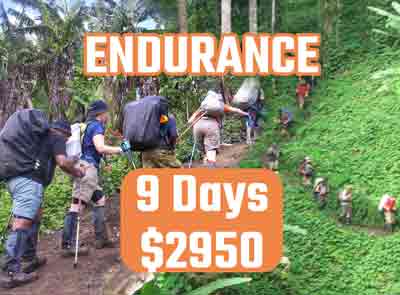Best Sunscreen Tips for Kokoda: A Comprehensive Guide to Sun Protection for Hikers
Introduction
Embarking on the Kokoda trek is a thrilling and challenging adventure, taking trekkers through the historic Kokoda Track in Papua New Guinea. Amidst the lush landscapes and rugged terrains, it’s essential to prioritize your skin’s health. This guide will walk you through the crucial aspects of choosing and applying sunscreen for optimum sun protection during your trek.
Understanding UV Rays
1. UV Radiation and its Impact
Before we delve into sunscreen specifics, let’s understand the enemy – UV radiation. The sun emits both UVA and UVB rays, which can lead to skin damage, sunburn, and an increased risk of skin cancer. Being prepared with the right sunscreen is your first line of defence.
2. SPF and Its Significance
SPF, or Sun Protection Factor, is a key factor in choosing sunscreen. The higher the SPF, the greater the protection. SPF 30 and SPF 50 sunscreens are recommended for the Kokoda trek due to the intense sun exposure.
Selecting the Best Sunscreen for Hiking
3. Waterproof and Sweatproof Formulas
Given the rigorous nature of the trek, opt for waterproof and sweatproof sunscreen. This ensures that the sunscreen remains effective even during intense physical activity and exposure to elements.
4. Mineral Sunscreen for Sensitive Skin
Consider using a mineral sunscreen with zinc oxide or titanium dioxide if you have sensitive skin. These ingredients provide a physical barrier, deflecting the sun’s rays without causing irritation.
5. Broad-Spectrum Protection
Choose a broad-spectrum sunscreen to shield against both UVA and UVB rays. This ensures comprehensive protection against the entire spectrum of harmful UV radiation.
6. Reef-Safe Sunscreens
Given the environmental impact, consider reef-safe sunscreens that are free from oxybenzone and octinoxate. Protecting your skin should not come at the cost of harming the environment.
Application Tips to Protect Yourself from the Sun
7. Regular Reapplication
Reapply sunscreen every two hours, especially during extended periods of sun exposure. Trekking through the Kokoda Trail demands consistent protection against the sun’s rays.
8. Pay Attention to High-Risk Areas
Don’t forget to apply sunscreen to often-neglected areas like the ears, back of the neck, and tops of the feet. These areas are susceptible to sunburn but are easily overlooked.
9. Including Your Face
Choose a sunscreen that is suitable for facial application. Mineral SPFs with a minimum of SPF 30 provide effective protection without clogging pores.
10. The Importance of a Wide-Brimmed Hat
Pair your sunscreen with a wide-brimmed hat for additional protection. A hat not only shields your face but also keeps your scalp and neck safe from the sun.
Protective Clothing and Gear to Assist Safe Sunscreens
11. Long Sleeve Clothing
Wearing long-sleeved clothing provides an extra layer of protection against UV rays. Look for clothing with a UPF (Ultraviolet Protection Factor) rating for added assurance.
12. UV-Protective Sunglasses
Protect your eyes from UV radiation by wearing sunglasses with UV-protective coatings. This reduces the risk of eye damage caused by prolonged sun exposure.
Additional Tips for Sun Protection with Your Outdoor Adventure
13. Hydration is Key
Drink plenty of water throughout your hike to stay hydrated. Proper hydration not only benefits your overall health but also supports your skin’s ability to resist sun damage.
14. Timing Matters
Plan your trek during the morning or late afternoon when the sun’s intensity is lower. This reduces the risk of sunburn and heat-related issues.
15. Know the Signs of Sun Damage
Educate yourself on the signs of sun damage, including early symptoms of sunburn. Being aware allows you to take prompt action and protect your skin.
Conclusion
As you prepare for your Kokoda trek, prioritizing sun protection is paramount. The right sunscreen, coupled with protective clothing and mindful application, will ensure you can fully enjoy the breathtaking landscapes without compromising your skin’s health. Choose the best sunscreen for your needs, reapply regularly, and embark on your adventure fully equipped to face the challenges of the Kokoda Trail.
FAQ’s
Q: What are the essential sun protection measures for hikers?
A: Hikers should wear sunscreen with SPF 30 or higher, wear protective clothing, sun hats, and sunglasses to protect themselves from harmful UV rays during their outdoor activities.
Q: How often should hikers apply sunscreen while hiking?
A: It is recommended to reapply sunscreen every two hours, especially if sweating or swimming, to ensure continuous protection from the sun.
Q: What is the difference between SPF 30 and SPF 50 sunscreen?
A: SPF 30 sunscreen provides 97% protection from UVB rays, while SPF 50 sunscreen provides 98% protection. Both are effective in providing UV protection when applied correctly.
Q: How can hikers protect their eyes from the sun during hiking?
A: Hikers can protect their eyes by wearing UV-protective sunglasses to shield their eyes from harmful UVA and UVB rays while hiking under the sun.
Q: What is the best sunscreen for hiking?
A: The best sunscreen for hiking is water-resistant, sweat-resistant, and offers effective protection against UVA and UVB rays. Look for sunscreens with SPF 30 or higher specifically designed for outdoor activities.
Q: Can wearing sunscreen prevent sunburn while hiking?
A: Yes, wearing sunscreen with adequate protection can help prevent sunburn and reduce the risk of skin damage caused by excessive sun exposure during hiking.
Q: How can hikers choose the right sunscreen for their hiking trips?
A: Hikers should choose sunscreen with high SPF, water-resistant and sweat-resistant properties, and consider mineral sunscreens for additional protection against the sun’s harmful rays during their hikes.
Q: What precautions should hikers take to protect their skin from the sun?
A: In addition to protecting the skin with sunscreen, hikers should also wear protective clothing, wide-brimmed hats, and UV-protective gear to minimize sun exposure and reduce the risk of sun damage.
Q: Can sun exposure during hiking cause skin cancer?
A: Prolonged sun exposure during hiking can increase the risk of skin cancer. It is important for hikers to use sun protection measures, such as sunscreen and protective clothing, to reduce this risk.




